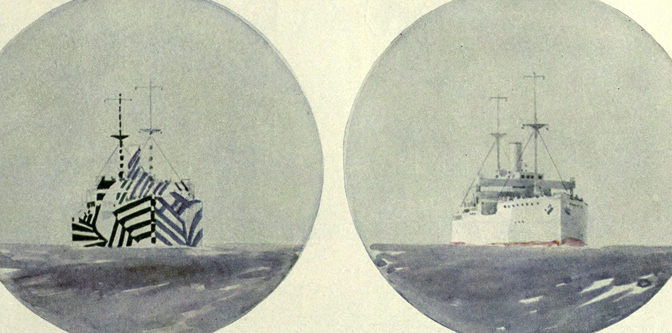WWI Dazzle

With Covid-19 comes writer’s block. It’s hard to write about hot rods and customs on a daily basis without inspiration… and it’s damn hard to get inspired without bombing around in something fast and loud. So, here I am… struggling along and doing the best I can to stay both motivated and inspired.
Today, I decided to take a break from it all and talk about something I’ve always been inspired by. During WWI, both the British and the American Navies were looking for a way to confuse enemy periscopes. Camouflage in the middle of the ocean was out of the question, but what if they could disguise the heading of their ships?
Dazzle painting was born by a British Marine artist named Norman Wilkerson. Essentially, he discovered that if you painted large ships with complex patterns of contrasting colors, it would be much harder from a distance to ascertain the ship’s bow from its stern and therefor, its heading. The idea proved somewhat effective and before long, the US Navy adopted the technique as well.
But beyond its effectiveness, the paint jobs gave the ships a striking appearance. So much so, that artists like Picasso began to take notice and inspiration. In fact, many historians credit the Cubist movement to Norman Wilkerson’s early art on battle ships.
There’s a lot more history and controversy to the subject, but I’m not all that interested in any of it. What has always intrigued me about Dazzling is the final look achieved by the random blocking. It’s something I’ve always felt could be interpreted in the hot rod world if done subtly, but also something I’ve never quite gotten my mind around.
Maybe someday…
Until then, however, I thought maybe you guys could take some inspiration from it as well. A guy named Maurice Freedman was the camoufleur for the 4th district of the US Shipping board. And, lucky for us, he saved all of his work.
Check it out:
- daz221
- DAZ 160
- daz224
- daz225
- daz222
- daz223
- daz216
- daz219
- daz219
- daz218
- daz220
- daz217
- daz214
- daz215
- daz212
- daz213
- daz206
- daz209
- daz208
- daz211
- daz210
- daz207
- daz204
- daz203
- daz202
- daz194
- DAZ 141
Amazing, right? You can see more here.
And just to close this out… Here’s some shots of some ships in the field disguising their heading:






































